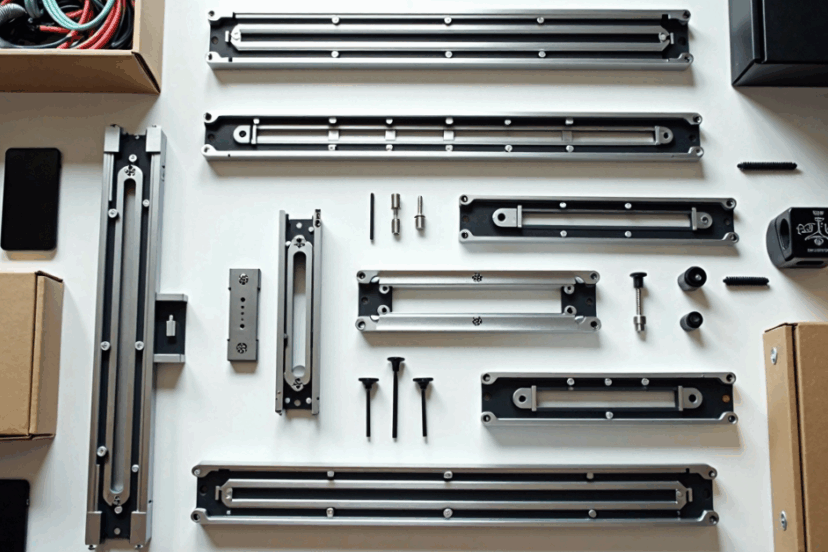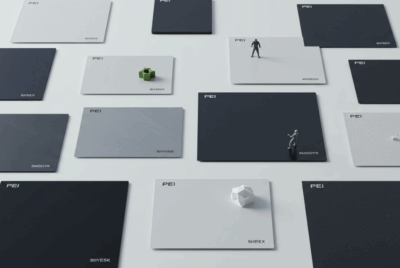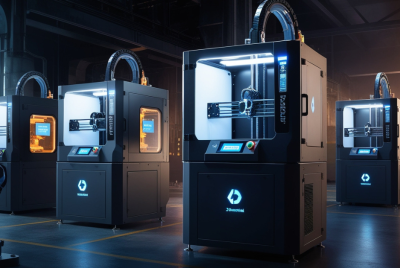2025 Buyer’s Guide: Top-Rated Linear Rails & Motion Systems for 3D Printers
Ever wondered why some 3D printers churn out flawless prints while others wobble like a toddler on a tricycle? The secret often lies in their linear rails & motion systems. These unsung heroes guide your printer’s movements, ensuring precision and speed. In 2025, with 3D printing tech racing forward, choosing the right linear rails can make or break your printing game. Whether you’re upgrading your Ender 3 or building a beastly Voron, this guide will walk you through the top-rated linear rails and motion systems to supercharge your prints. Ready to dive in?
What Are Linear Rails & Motion Systems?
Think of linear rails as the backbone of your 3D printer’s movement. They’re the tracks that guide the print head or bed along the X, Y, and Z axes, ensuring smooth, precise motion. Motion systems, including belts, screws, and actuators, work with rails to convert motor power into linear movement. Without them, your printer would be like a car without a steering wheel—chaotic and unpredictable.
Linear rails come in various flavors: V-slot profiles, T-slot extrusions, linear rods, and true linear rails. Each has its quirks, but they all aim to keep your printer’s movements as steady as a surgeon’s hand. Why does this matter? Because even a tiny wobble can turn your masterpiece into a melted mess.
Why Linear Rails Matter for 3D Printing
Let’s get real: nobody wants blurry prints or a printer that sounds like it’s auditioning for a horror movie. Linear rails are the key to crisp, high-quality prints. They reduce friction, minimize vibrations, and ensure your print head moves exactly where it’s supposed to. Plus, they can handle high speeds without shaking like a leaf, which is crucial for 2025’s lightning-fast printers like the Creality K2 Plus.
Precision is everything in 3D printing. A good linear rail system can mean the difference between a model with razor-sharp details and one that looks like it was sculpted by a toddler. And with modern printers pushing 300mm/s or more, sturdy rails keep things stable, so your prints don’t end up looking like abstract art.
Types of Linear Rails for 3D Printers
Not all linear rails are created equal. Here’s a quick rundown of the main types you’ll encounter:
- V-Slot Profiles: These aluminum extrusions have a V-shaped groove for wheels. They’re affordable and double as a frame, but aluminum’s lower stiffness means they’re best for smaller printers.
- T-Slot Profiles: Similar to V-slots but with a T-shaped groove, these are versatile for DIY builds but share the same rigidity limitations.
- Linear Rods: Cylindrical steel rods paired with ball bearings. They’re cheap and reliable but require two rods per axis, making setups bulkier.
- True Linear Rails: Steel rails with dovetail tracks and carriages. They’re pricier but offer unmatched precision and rigidity, perfect for high-end builds.
Each type has trade-offs. V-slots are budget-friendly but less precise, while true linear rails are the gold standard for pro-grade printers. Your choice depends on your printer’s size, speed, and your wallet’s depth.
Key Features to Look for in Linear Rails
Shopping for linear rails can feel like navigating a maze. Here are the must-have features to keep an eye on:
- Material Quality: Look for hardened steel or stainless steel for durability. Aluminum is lighter but less rigid.
- Load Capacity: Ensure the rail can handle your printer’s weight, especially for large-format machines.
- Precision: Tight tolerances mean straighter motion and better prints. Check for high machining accuracy.
- Maintenance Needs: Self-lubricating rails like Igus DryLin save you from constant upkeep.
- Compatibility: Make sure the rail fits your printer’s design (e.g., Ender 3 kits for Creality models).
A rail that ticks these boxes will keep your printer humming along like a well-tuned sports car.
Top 10 Linear Rails for 3D Printers in 2025
Ready to upgrade your printer? Here are 10 top-rated linear rails and motion systems for 2025, all brands with proven track records.
- HIWIN MGN12H Linear Rail
HIWIN’s MGN12H is a compact, high-precision rail perfect for small to medium printers. Its stainless steel construction and low-friction bearings ensure smooth, quiet operation. Ideal for Voron or Ender 3 upgrades, it handles high speeds with ease. The catch? It’s pricier than rods, but the performance is worth it.
- Igus DryLin W Linear Rail
The Igus DryLin W is a maintenance-free champ. Its self-lubricating design means no greasy fingers, and its lightweight aluminum body suits small printers. It’s not as rigid as steel rails, but for hobbyists, it’s a low-hassle winner.
- Creality Ender 3 Linear Rail Kit
Creality’s official kit is a budget-friendly upgrade for Ender 3, V2, or Pro users. It swaps V-slot wheels for MGN12H rails, boosting precision and reducing noise. Installation is a breeze, making it perfect for beginners.
- THK Linear Motion Guides
THK’s linear guides are the Rolls-Royce of rails. Used in robotics and aerospace, they offer unmatched rigidity and accuracy. They’re overkill for most hobbyists but ideal for professional-grade printers like the Ultimaker S5. Expect a premium price tag.
- BestEquip Linear Rail Slide
This kit includes 1000mm chrome-plated shafts and SC20UU bearings, great for DIY printers or CNC machines. It’s affordable and durable but requires regular lubrication. A solid pick for budget-conscious builders.
- GUWANJI SBR12 Linear Rails
The GUWANJI SBR12 kit offers two 1000mm rails and four SBR12UU blocks. Its pre-drilled holes make installation a snap, and the high-precision bearings ensure smooth motion. Great for mid-sized printers or CNC projects.
- Feyrinx Linear Rods
Feyrinx’s 6mm chrome-plated rods are a cost-effective choice for small printers. With 55-60 HRC hardness, they’re durable and corrosion-resistant. Pair them with LM6UU bearings for budget builds.
- LDO Linear Rails
LDO’s rails are a favorite for Voron builders. Their hardened steel construction and tight tolerances deliver silky-smooth motion. They’re pricier than generic rails but a must for high-speed, high-precision prints.
- PMI Linear Guides
PMI’s guides are built for industrial applications, offering top-tier precision and load capacity. They’re great for large-format printers or heavy-duty CNC setups. Not cheap, but they’re built to last.
- NSK Linear Guides
NSK’s linear guides are known for durability and energy efficiency. They’re ideal for heavy-duty printers that run long hours. Their high-quality bearings reduce wear, making them a smart long-term investment.
How to Choose the Right Linear Rail for Your Printer
Picking the perfect linear rail is like choosing the right pair of shoes—it needs to fit your needs and feel good. Ask yourself:
- What’s your budget? Rods and V-slots are cheaper, while true rails cost more.
- How big is your printer? Large printers need rigid rails like THK or PMI.
- How fast do you print? High-speed printers demand low-friction rails like HIWIN or LDO.
- DIY or plug-and-play? Kits like Creality’s Ender 3 rail are easier for beginners.
Match the rail to your printer’s specs and your skill level. A Voron builder might splurge on LDO rails, while an Ender 3 tinkerer might stick with Creality’s kit.
Installation Tips for Linear Rails
Installing linear rails isn’t rocket science, but it’s not a five-minute job either. Here’s how to nail it:
- Check Parallelism: Ensure rails are perfectly parallel to avoid binding. Use a caliper or laser level.
- Secure the Frame: A wobbly frame ruins precision. Tighten all bolts before mounting rails.
- Lubricate Bearings: Apply a thin layer of grease to reduce friction (unless using self-lubricating rails like Igus).
- Test Movement: Move the carriage by hand to check for smoothness before powering up.
- Calibrate: Adjust belt tension and homing settings after installation to avoid errors.
Take your time, and you’ll have a printer that glides like it’s on ice.
Maintenance Best Practices for Linear Rails
Want your rails to last? Treat them like your favorite pair of sneakers—clean and care for them. Wipe down rails weekly to remove dust and filament debris. For steel rails, apply lubricant every few months to keep bearings happy. Self-lubricating rails like Igus DryLin need less fuss, but still check for wear. If you notice jerky motion or odd noises, inspect for debris or damaged bearings and replace parts as needed. Regular TLC keeps your printer running like a dream.
Future Trends in Linear Rails for 3D Printing
What’s next for linear rails? In 2025, we’re seeing lighter, stronger materials like carbon fiber rods gaining traction for their stiffness-to-weight ratio. Self-aligning rails with built-in sensors are also emerging, making installation and calibration easier. And with printers hitting 500mm/s, expect rails with even lower friction and higher load capacities. The future is fast, precise, and oh-so-smooth.
Conclusion
Linear rails & motion systems are the heart of any great 3D printer. They’re what make your prints sharp, your speeds blazing, and your sanity intact. Whether you’re grabbing a budget-friendly Creality kit or splurging on THK guides, the right rail can transform your printing experience. Use this 2025 buyer’s guide to pick a system that fits your printer, budget, and dreams. Ready to level up your 3D printing? Get those rails installed and start printing like a pro!
FAQs
- What’s the difference between linear rods and linear rails?
Linear rods are cylindrical and use bearings, requiring two per axis for stability. Linear rails are flat tracks with carriages, offering better rigidity and precision with just one rail per axis. - Are linear rails worth the upgrade for my Ender 3?
Absolutely! Upgrading to rails like the Creality Ender 3 kit boosts precision and reduces noise, especially for high-speed printing. - How often should I lubricate my linear rails?
For steel rails, lubricate every 2-3 months or after heavy use. Self-lubricating rails like Igus DryLin need minimal upkeep. - Can I use linear rails on a large-format printer?
Yes, but choose rigid rails like THK or PMI with high load capacity to handle the weight and size. - What’s the best linear rail for a Voron build?
LDO or HIWIN MGN12H rails are top picks for Voron builds due to their precision and smooth motion at high speeds.




